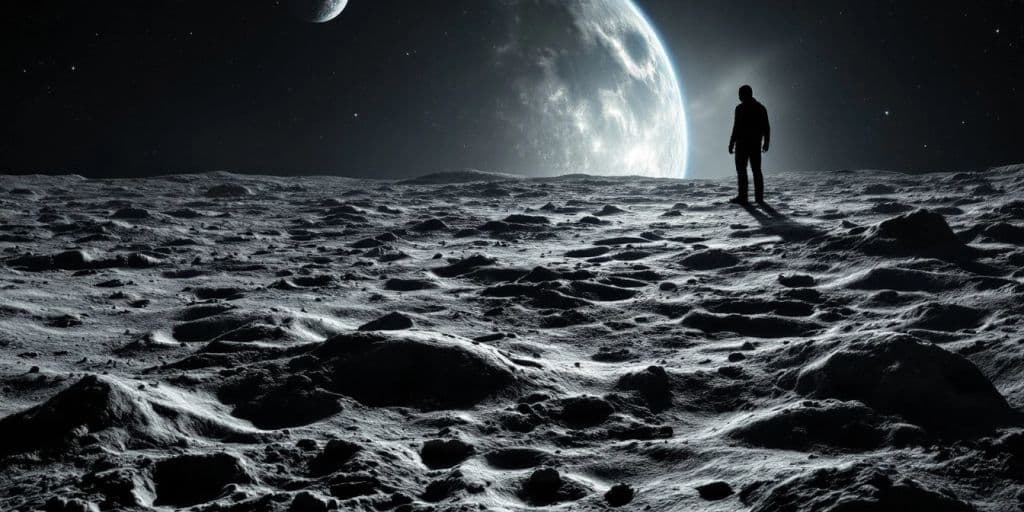The belief that the moon landing was a hoax continues to spark debates and discussions even decades after the event. This theory, which suggests that NASA staged the moon landings to win the space race against the Soviet Union, has captivated many, despite overwhelming evidence proving its falsity. In this article, we will explore the origins of the moon landing hoax theory, the arguments made by its believers, and the cultural impact it has had over the years.
Key Takeaways
- The moon landing hoax theory began with Bill Kaysing’s pamphlet in the 1970s.
- Despite solid evidence like moon rocks and third-party verifications, some still believe the landings were faked.
- The theory has been popularized through movies, TV shows, and social media.
- Psychological factors and distrust in institutions play a role in the persistence of this belief.
- Efforts to educate the public about the moon landings continue, but skepticism remains high.
Origins of the Moon Landing Hoax Theory
Bill Kaysing’s Influence
In 1976, Bill Kaysing published a book titled We Never Went to the Moon: America’s Thirty Billion Dollar Swindle. This book is often credited with starting the conversation about the moon landing being a hoax. Kaysing, who had a background in technical writing, claimed that the chances of a successful moon landing were only 0.0017%. His ideas gained traction and sparked interest in conspiracy theories surrounding the Apollo missions.
Early Skepticism and Media Portrayal
Skepticism about the moon landing was present even during the Apollo missions. Movies like Diamonds Are Forever (1971) included jokes about faked landings, which helped to plant seeds of doubt in the public’s mind. The portrayal of the moon landing in popular culture often leaned towards skepticism, making it easier for conspiracy theories to flourish.
Initial Public Reaction
When Kaysing’s book was released, it resonated with a segment of the public that was already skeptical of government narratives. Polls from the late 1990s to the 2000s showed that between 6% and 20% of people believed the landings were faked. This belief was fueled by a growing distrust in government and media, especially in the post-Vietnam War era.
The moon landing hoax theory reflects a broader cultural skepticism towards authority and official accounts.
Summary
The origins of the moon landing hoax theory can be traced back to Bill Kaysing’s influential book, early media portrayals, and a public eager to question government narratives. This combination created a fertile ground for conspiracy theories to take root and persist over the decades.
Highlights
- Bill Kaysing’s Influence: His book sparked the initial conspiracy theories.
- Early Skepticism: Movies and media contributed to public doubt.
- Public Reaction: A significant portion of the population questioned the moon landings.
Key Arguments of Moon Landing Hoax Believers
Photographic and Video Evidence
Many conspiracy theorists argue that the photos and videos from the Apollo missions are not genuine. They claim:
- Stars are missing in the photos, which they believe should be visible.
- There is no blast crater under the lunar lander, suggesting it was filmed on Earth.
- The shadows in the images appear to be inconsistent, leading to doubts about the lighting conditions.
Technical Feasibility Concerns
Skeptics often question whether the technology of the 1960s was advanced enough to achieve a moon landing. They argue that:
- The Van Allen radiation belts would have been deadly for astronauts.
- The Lunar Module was too fragile to survive the harsh conditions of space.
- The telemetry data from the missions is often cited as being manipulated or lost.
Astronaut Testimonies and Anomalies
Some believe that astronauts have made statements that contradict the official narrative. They point to:
- Buzz Aldrin’s alleged reluctance to discuss certain aspects of the mission.
- Claims of anomalies in astronaut behavior during interviews.
- The idea that some astronauts have hinted at a cover-up, fueling further speculation.
The persistence of these theories highlights a deep mistrust in the government and a tendency to seek alternative explanations for major events.
These arguments continue to fuel the belief in the moon landing hoax, despite overwhelming evidence to the contrary, including scientific studies and moon rocks that have been verified by multiple countries.
Debunking the Moon Landing Hoax
Scientific Evidence and Moon Rocks
The moon landings are backed by strong scientific evidence. Over 382 kilograms of moon rocks were brought back to Earth, and scientists have confirmed that these rocks are unlike any found on our planet. They contain unique isotopes that prove they originated from the moon.
Third-Party Verifications
Many countries, including Russia, Japan, and China, have verified the moon landings. They tracked the Apollo missions and confirmed that the U.S. astronauts did indeed land on the moon. This international verification adds credibility to the claims of the moon landings.
NASA’s Rebuttals
NASA has consistently responded to hoax claims. In 1977, they released a fact sheet stating that the idea of faking the moon landings is preposterous. They pointed out that the operations were closely monitored by the media, and the evidence, including the moon rocks, is irrefutable.
The moon landing is a monumental achievement in human history, and the evidence supporting it is overwhelming.
Summary of Key Points
- Moon Rocks: Unique isotopes confirm lunar origin.
- International Tracking: Other countries verified the missions.
- NASA’s Transparency: Continuous rebuttals to hoax claims.
Despite the overwhelming evidence, some people still believe in the hoax. This belief often stems from psychological factors and the influence of media, which can perpetuate myths and misinformation.
Conclusion
The moon landing hoax theory has been thoroughly debunked through scientific evidence, third-party verification, and NASA’s transparent responses. Yet, the persistence of these beliefs highlights the complex relationship between fact and perception in our society.
Cultural Impact of the Moon Landing Hoax
Representation in Movies and TV Shows
The moon landing hoax theory has made its way into various forms of entertainment. Movies and TV shows often use this conspiracy as a plot device. For example:
- "Capricorn One" (1978): A film about a faked Mars landing that popularized the idea of staged space missions.
- "The X-Files": This show frequently explored conspiracy theories, including the moon landing hoax, keeping it alive in public discourse.
- "Futurama" and "Friends": Both shows referenced the moon landing hoax, showing its influence on popular culture.
Influence on Other Conspiracy Theories
The moon landing hoax has also impacted other conspiracy theories, such as:
- Flat Earth Theory: Both share a distrust of scientific authority.
- 9/11 Truth Movement: Some argue that if the moon landing was faked, other major events could be too.
- COVID-19 Conspiracies: Recent claims suggest that the government has manipulated information, similar to the moon landing narrative.
Public Perception Over Time
Surveys indicate that a small but significant portion of the population still believes in the moon landing hoax. For instance, around 5% of Americans maintain this belief, which translates to millions of people. This enduring skepticism reflects a broader trend of distrust in government and scientific institutions.
The moon landing hoax theory serves as a lens through which many view authority and the information presented to them. It highlights a cultural fascination with questioning reality and the narratives constructed by those in power.
Why the Moon Landing Hoax Theory Persists
Psychological Factors
Many people are drawn to conspiracy theories because they offer simple explanations for complex events. Believing in a hoax can provide a sense of control in a confusing world. Here are some reasons why:
- Distrust in Authorities: Many individuals feel that governments and organizations are not truthful.
- Need for Certainty: Conspiracy theories can fulfill emotional needs for certainty and understanding.
- Community: Believing in these theories can create a sense of belonging among like-minded individuals.
Role of the Internet and Social Media
The rise of the internet has made it easier for conspiracy theories to spread. Here are some key points:
- Rapid Sharing: Information can go viral in minutes, reaching a wide audience.
- Echo Chambers: People often only see views that match their own, reinforcing their beliefs.
- Influencer Impact: Popular figures can sway opinions, making conspiracy theories seem more credible.
Comparison with Other Conspiracy Theories
The moon landing hoax theory shares similarities with other conspiracy theories, such as:
- 9/11 Inside Job: Some believe the government was involved in the attacks.
- COVID-19 Plannedemic: The idea that the virus was deliberately created for control.
- Area 51 and Aliens: Speculations about government cover-ups regarding extraterrestrial life.
The persistence of the moon landing hoax theory highlights how media and social dynamics can shape public beliefs. Understanding these factors is crucial in addressing misinformation and promoting critical thinking.
Efforts to Educate and Dispel Myths

Documentaries and TV Programs
Many documentaries and TV shows have tackled the moon landing hoax theory. These programs aim to present factual evidence and expert opinions to counter the myths. Some notable examples include:
- "Apollo 11: The True Story"
- "The Moon Landing: A Hoax?"
- "MythBusters: Moon Landing"
These shows often use scientific explanations and visual evidence to clarify misconceptions.
Educational Initiatives by NASA
NASA has taken significant steps to educate the public about the moon landings. Their efforts include:
- Public lectures and workshops
- Interactive exhibits at museums
- Online resources and educational materials
These initiatives aim to engage younger audiences and encourage critical thinking about space exploration.
Public Figures and Scientists Speaking Out
Many scientists and public figures have spoken out against the moon landing hoax theory. Their efforts include:
- Phil Plait, known as "The Bad Astronomer," frequently debunks myths on social media.
- Neil deGrasse Tyson, an astrophysicist, often discusses the importance of scientific literacy.
- Buzz Aldrin, one of the first astronauts on the moon, actively defends the reality of the moon landings.
The ongoing battle against misinformation requires constant effort and clear communication. Public understanding is key to dispelling myths and fostering a culture of inquiry.
The Future of Moon Landing Hoax Beliefs

Potential for New Revelations
The ongoing exploration of the Moon may bring new evidence that could challenge the beliefs of hoax theorists. As technology advances, we might uncover more data that supports the reality of the moon landings.
Impact of Future Lunar Missions
Upcoming missions, like NASA’s Artemis program, aim to return humans to the Moon. These missions could provide fresh insights and first-hand experiences that may sway public opinion.
Ongoing Public Interest and Skepticism
Despite overwhelming evidence, about 5% of Americans still believe the moon landings were faked. This persistent skepticism can be attributed to:
- Psychological factors that make conspiracy theories appealing.
- The role of the internet, which allows misinformation to spread quickly.
- A general distrust in government and institutions.
The belief in conspiracy theories often reflects a deeper mistrust in authority and a desire for alternative explanations to complex events.
As we look to the future, the moon landing hoax theory may continue to evolve, influenced by new discoveries and the ever-changing landscape of public opinion.
As we look ahead, the beliefs surrounding the moon landing hoax continue to spark curiosity and debate. It’s essential to explore these ideas critically and understand their origins. For those eager to dive deeper into this fascinating topic, visit our website for a wealth of resources and insights that can enhance your understanding. Don’t miss out on the chance to expand your knowledge!
Conclusion
In conclusion, the belief that the moon landing was a hoax continues to thrive, even decades after the event. Despite overwhelming evidence proving that astronauts did indeed walk on the moon, many people still cling to this conspiracy theory. This persistence can be attributed to a mix of skepticism towards authority, the influence of popular culture, and the ease of spreading misinformation online. As we look to the future, it’s important to encourage critical thinking and promote scientific literacy to help combat these unfounded beliefs. The moon landing is a remarkable achievement in human history, and it deserves to be celebrated as such.
Frequently Asked Questions
What started the idea that the moon landing was fake?
The belief that the moon landing was a hoax began with Bill Kaysing, who published a pamphlet in 1976 claiming it was all a scam to win the space race.
What do people who believe in the hoax say about the photos from the moon?
Some hoax believers argue that the photos and videos from the moon look fake, claiming there are no stars visible and questioning the shadows.
How has NASA responded to the moon landing conspiracy?
NASA has provided a lot of evidence, including moon rocks and images from space missions that show landing sites, to prove the landings were real.
Why do some people still believe the moon landing was faked?
Many people hold onto conspiracy theories due to distrust in the government and the influence of the internet, which spreads these ideas.
What cultural impact has the moon landing hoax had?
The moon landing hoax has influenced movies, TV shows, and other conspiracy theories, keeping the idea alive in popular culture.
Can documentaries change people’s minds about the moon landing hoax?
While some documentaries aim to debunk the hoax, they often have little effect on true believers who are set in their views.




